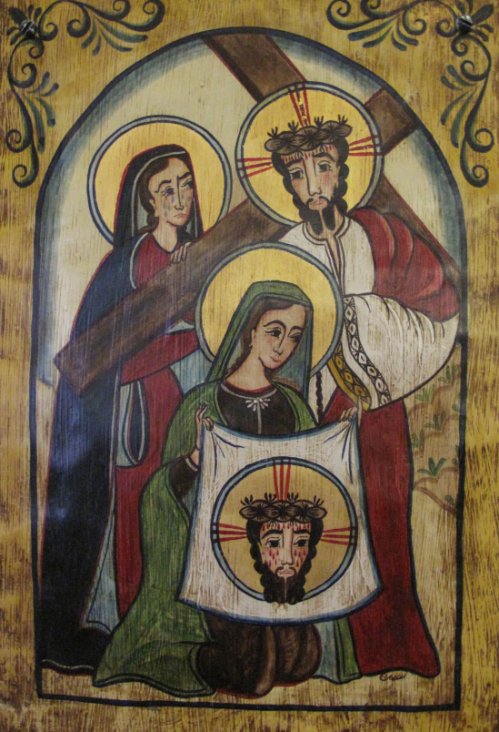
I’ve been doing a 50th anniversary commemoration book for our Episcopal parish, and as part of the project I’ve been photographing the Stations of the Cross on the church walls. I’m strictly a hobby photographer, and admit a little sheepishly that I haven’t gone through my camera’s manual yet, page by page. So I found it a little startling when I aimed my new Canon G10 at the first station, and the camera identified Jesus’ face. The Canon G10 identifies faces for a couple of reasons, from eliminating redeye to starting the timer when an additional face (presumably the photographer’s) enters the field of view. It puts brackets around them when it identifies them.
The station depictions at our church are not photorealistic. They are done in the distinctive Mexican primitive style, by the well-known Mexican-American artist Mario Larrinaga, who (among many other things) was a matte artist for the original 1933 film King Kong. The stations are painted icons, deliberately lacking any suggestion of a third dimension (so that they cannot be mistaken for the biblically prohibited “graven images”) and as such they resemble cartoons more than portraits.
It got me thinking about how cameras identify faces. As I worked my way around the church, a pattern began to emerge. For the image above (Station #6, depicting Jesus, Mary, and Veronica) the camera tagged Jesus’ face twice–once in person and once on Veronica’s veil–but did not consistently identify the face of the Blessed Mother. Veronica did better, but not nearly as well as Jesus. The brackets flickered and did not stay on consistently.
When I got home, I tried a few other things. I brought up Google Images and aimed the camera at screen images of the Mona Lisa, various Rembrandt portraits, and a few other things. The camera got most of them. I then pulled out a couple of Lynda Barry’s books, spread them open with bookweights, and tried to get the G10 to recognize Marlys and Maybonne. No deal, but some of their friends were picked up.
These seem to be the criteria:
- Faces need eyeballs. Marlys always has her Far Side glasses on. No eyeballs.
- Big eyes are better than small eyes, all else being equal. This seems to be Mary’s problem in the station image above.
- Faces need to be mostly human-shaped. Funny animals don’t cut it. But then again, neither did any of the characters in PVP. Tycho and Gabe were similarly snubbed. (It was odd to think of Marlys’ brother Freddie as being more “realistic” than Gabe.)
- Faces need to be looking more or less straight at the camera.
This last criterion seemed to be the most significant. Profiles were never recognized, and three-quarter views only about half the time. The closer a face was to dead-on, the better the camera recognized it.
So. Got redeye problems? What Would Jesus Do? Get a G10. And look straight at the camera.











Facial recognition is gradually moving from Star Trek wonderment to ho-hum ordinary checklist feature. The next step is building in into augmented reality apps. A request: A program for the iPhone that identifies people and does one of the following:
1. Good people – Fix minor skin blemishes. Straighten/whiten teeth. If they are extraordinarily good and/or have a pristine credit score perhaps a halo of some kind.
2. Bad people – Horns, naturally. Tint skin tone to red. Sharpen teeth. If they had anything to do with the mortgage-backed securities or structured investment vehicles… big fangs and forked tongue.
3. Goofy people – Absurd mustache. Van Dyke beard. Black-out a tooth or two. Maybe even an eye patch.
You’ll correctly point out there’s a little of all three in most of us. The design takes that into account. You might easily have a grinning angel missing a tooth or possibly a demon with a silly, twirly mustache. Flexibility is key.